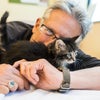
Day 8: There is so much to say about lions. We see lions everywhere. Prides. Such a right term that: Pride. Proud. They are noble, regal, majestic, handsome, strong, magnificent. These are striking animals. Habituated as they obviously are to our vehicles, one is almost drawn to reach out a hand to touch the lions. Almost... I suspect that would be a very good way to lose a hand.
We've spent a fair amount of time over the past days watching this one mother lion and her cubs. They're part of a pride which appears to be made up of eight other adults, although this nursing mom has moved herself and her babies a short distance from the rest.
While an adult lion deserves strong and powerful adjectives more so than any other animal I can think of, it is impossible to think of these cubs as anything other than adorable. They are impossibly big kittens, staring with kitten wide-eyed innocence, clumbering on over-sized feet, playing lazily with each other in the heat of the day. Mom gave birth to her six cubs less than three weeks ago, and lost two of them almost immediately. We're told that is the norm, with the mother able to only feed four hungry mouths. Harder to accept than that, however, are the obvious injuries to the mother's face and inner right thigh, as well as the death just the other night of one more of her kittens.
Hyenas, we're told. A group of spotted hyenas attacked the babies and the mother defended them. Hyenas, it appears, are among the most successful as well as most common predators here in the East African savannah. These are fierce animals who often hunt in groups, with as many as 80 individuals making up a colony. Hyenas typically go after larger herbivores (Thompson's gazelle, topi, zebra). However, the delayed migration of such relatively easy prey, especially their young, likely made it too hard to resist these cubs: babies who on their own would be defenseless, but who were well defended by their mother.
The four of us may just be tourists, but between us we've got about a century's worth of professional experience working with animals, and one of us is a veterinarian. A day ago we left this scene feeling that all was lost: that the mother would not survive another attack, that the babies would then be easy prey, and that despite all our best wishes and worried pondering there was nothing that we could do or that anyone could do to change the most likely outcome. The one thing we didn't count on heavily enough was that mother lion.
If my cats' tongues are like sandpaper, this lion's is a grinding machine. Worrying nonstop at the wounds, they're now thoroughly abraded, the infection has burst, and her natural vigor has gotten her over the worst of it. She and her cubs are all obviously stronger than when we first saw them. We will leave this part of Tanzania tomorrow morning with every reason to expect she, and her babies, will survive.
The irony is of course right there to see: We are celebrating the fact that most of the members of this family of lions have survived a deadly attack so that they can attack and kill other animals. Our celebratory mood, however, is not because we find this lioness or her babies more deserving of life than the zebra or giraffe they will kill, but because we spent enough time watching them to begin to care about them as individuals. None of that matters to them of course, but it does to us.
We've not seen a kill, and while it would be OK to watch a successful hunt that's frankly not been high on my list. There is plenty of evidence everywhere you turn that you're smack dab in the middle of an eco-system heavily defined by predator-prey relationships. A gutted zebra, head gone, entrails and organs missing from the ripped open ribcage; skulls and vertebrae litter the ground, most of them picked clean and bleached white from the sun; cries day and night of animals hunting and animals being hunted.
Earlier today we watched, amazed, as three young male lions from this same pride became alert to a small herd of Grant's gazelle. Somehow, in some way we could not hear or see, they signaled to each other. The three moved off, forming three points of a widely spaced triangle, until determining that the target of their attention was too far off and the wind not right. Two returned back to the shade of the umbrella acacia and watched, as did we, the optimist of the group stalk and utterly fail at making a meal of a Secretary bird, a large predatory bird who is quite imposing in his own right. A bird who, no doubt, went on to fill his own belly with several snakes and lizards before this day was over.
